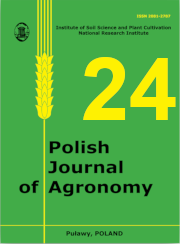Speciation of Cd and Pb in the soil after the biochar application
Main Article Content
Abstract
The focus on speciation analytics, which allows identification of the potential risks to the environment arising from the presence or accumulation of heavy metals in soil, has been on the increase in the recent years. Total or, at least, partial detoxification of heavy metal ions, to variable extents, can be achieved by introducing biochar into the soil. The key factor and potential of biochar to reduce the content of heavy metals in soil depends on the specific properties of biochar, such as presence of functional surface groups, specific surface area, and porosity. The aim of the research was to evaluate the effect of poultry litter, as well as poultry litter-derived biochar produced at a temperature of 300 oC on Cd and Pb contents in mobile and organic matter-bound forms in soil. A micro-plot field experiment was established on Haplic Cambisol with five treatments: control soil without fertilisation; soil + NPK; soil + NPK + poultry litter at a dose of 5 t D.M. ha-1; soil + NPK+ biochar at a dose of 2.25 t D.M. ha-1, and soil + NPK + biochar at a dose of 5 t D.M. ha-1. The soil samples were taken from each plot, from the layers: 0–10 cm, 10–20 cm and 20–30 cm. the following parameters were determined: pH – by potentiometric method, electrical conductivity – by conductometric titration, the contents of total forms of nitrogen and carbon were determined using CNS analyser. The contents of total forms of selected trace elements were determined after ashing the soil organic matter in chamber furnace (at 450 °C for 8 hours) and mineralising its residues in a mixture of concentrated nitric and perchloric acids. Selected forms of analysed trace elements (the sum of mobile, exchangeable, MnOx- and organic matter-bound fractions) were determined by the sequential extraction procedure designed by Zeien and Brümmer. The Cd and Pb contents in the resulting solutions and extracts were determined by ICP-OES using the Perkin Elmer Optima 7300 DV instrument. The sum of exchangeable alkaline cations (EAC) and hydrolytic acidity (Hh) were determined by Kappen method. It was noted that the total lead content, regardless of the soil layer (0–10 cm, 10–20 cm and 20–30 cm), ranged between 19.8 mg and 28.9 mg kg-1 D.M. of soil, and the total cadmium content, between 0.61 mg and 1.16 mg kg-1 D.M. of soil. The average proportion of the sum of the most mobile forms of cadmium in the total Cd content in 0– 10 cm, 10–20 cm and 20–30 cm soil layers was: 82%, 76% and 63% respectively, and of lead, 22%, 20% and 24%. The proportion of lead fraction bound with organic matter in the total content was comparable in different soil layers and ranged between 37% and 41%. No Cd fraction bound to organic matter was determined in the tests.
Article Details

This work is licensed under a Creative Commons Attribution-ShareAlike 4.0 International License.
The author grants the editorial staff of the Polish Journal of Agronomy (abbreviated as PJA) a non-exclusive and royalty-free license to use the author's copyright in the paper/printed and electronic versions of his/her work published in PJA in Poland and abroad, in whole or in any part, including placing the work in electronic databases/databases locally or available on the Internet, for an unlimited period of time in the fields of exploitation specified in article 50 of the Copyright and Related Rights Act.
Manuscripts published in Polish Journal of Agronomy are available under a Creative Commons Attribution-ShareAlike 4.0 (CC-BY-SA) license.

